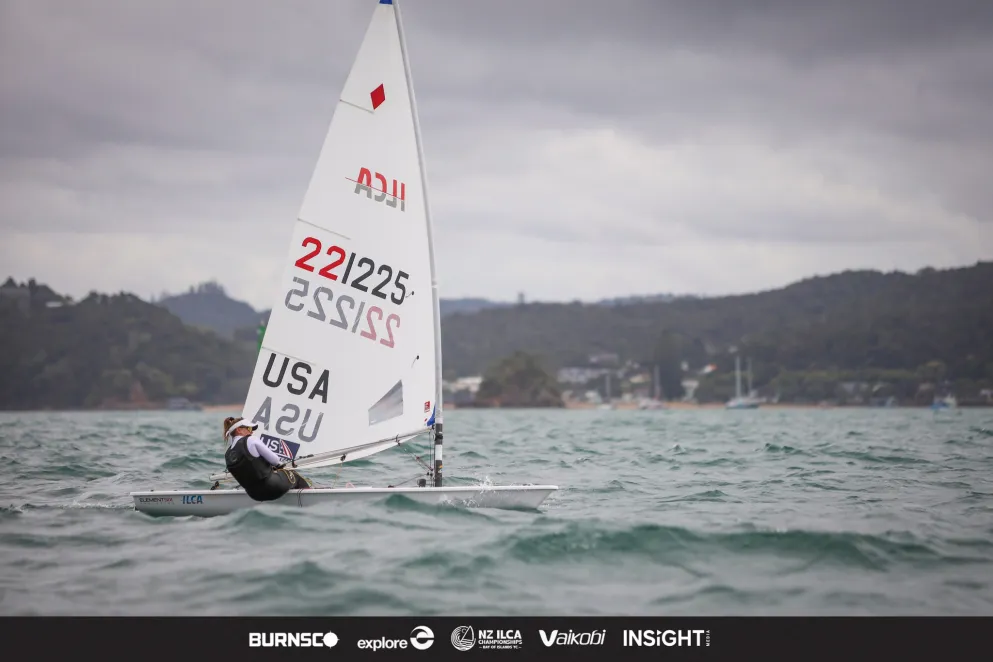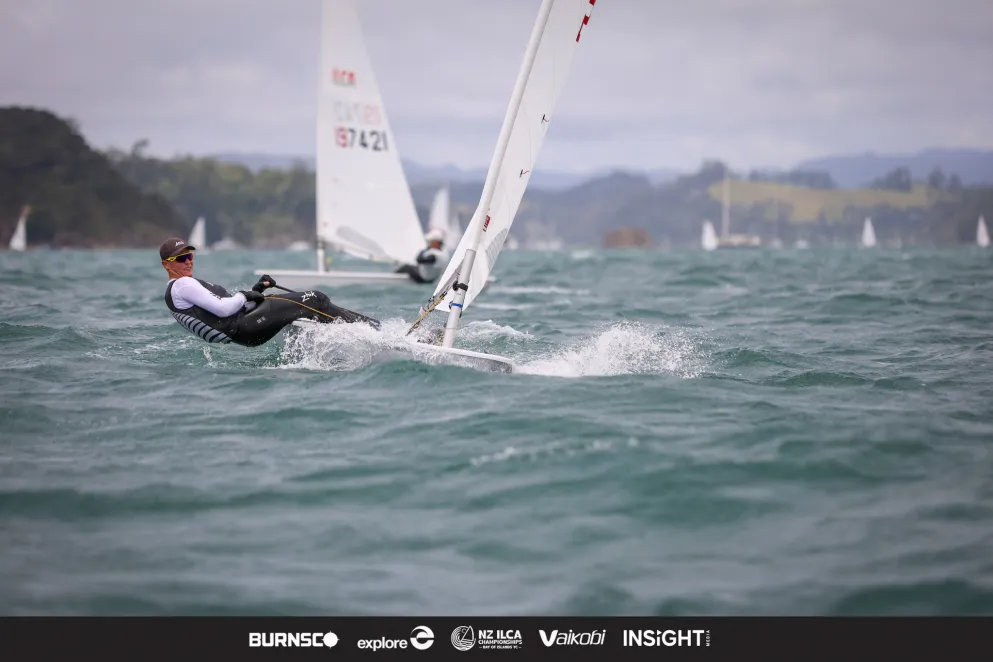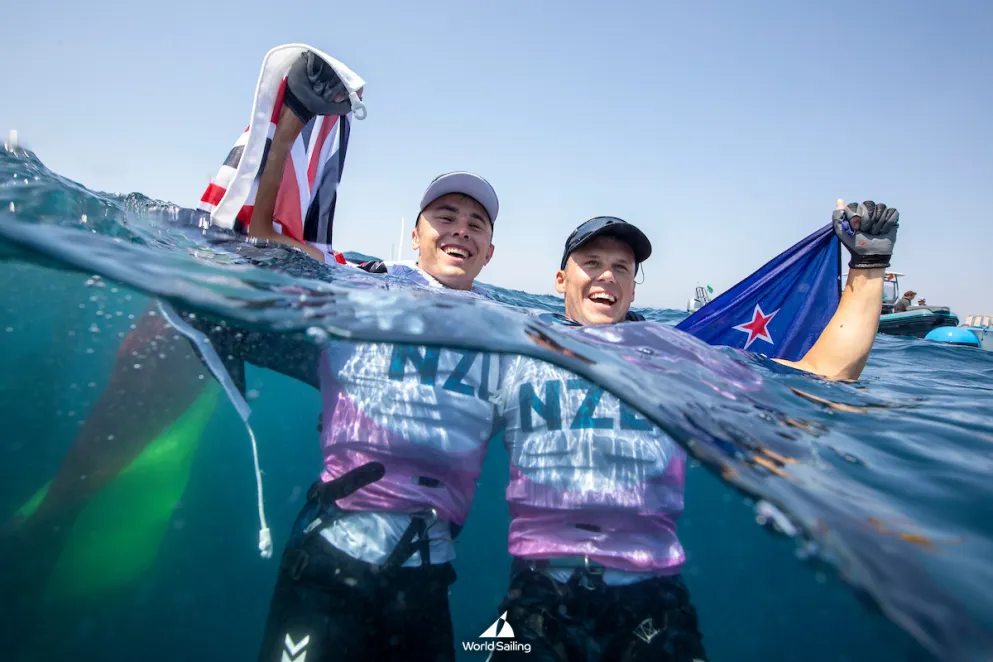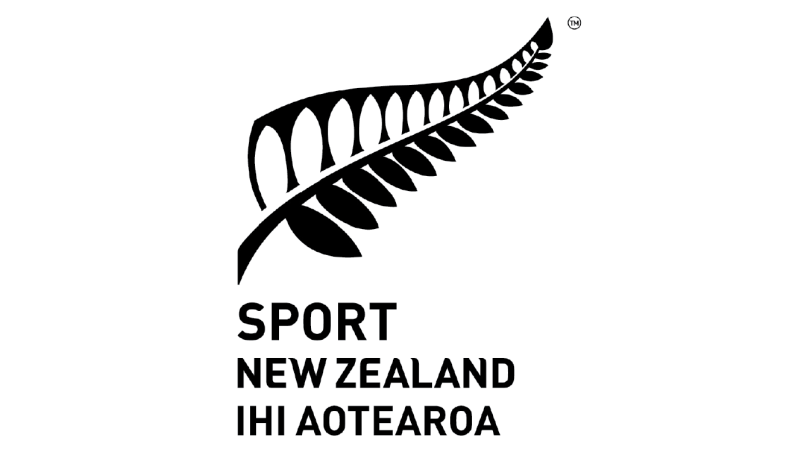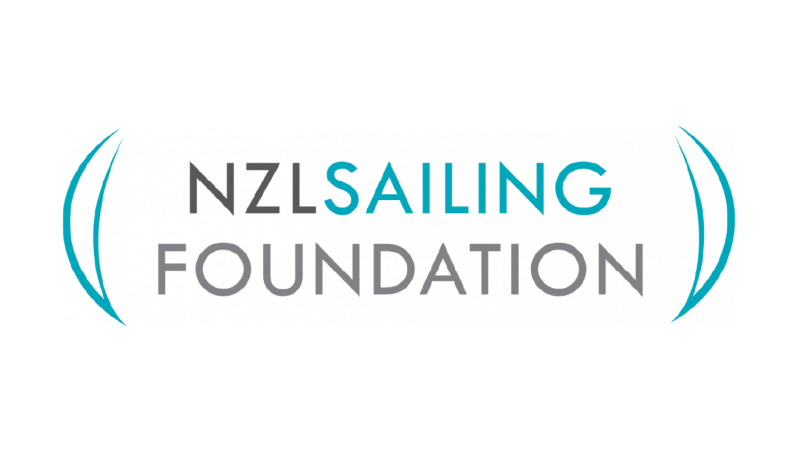Graeme Robinson - recipient of a prestigious Uffa Fox Medal
It’s been a big and successful few years for Graeme Robinson in the F15 world. Despite the personal challenges of working intensively with Christchurch's earthquake recovery, in 2011 he won the first heat of the 18th World Championships at Hayling Island with James Sandall after 25 years of trying. He had a short term as FFI Commodore (more on that below). He was master of ceremonies at the 50th New Zealand National Championship Reunion Dinner and Prize Giving in 2013 and competed in his 12th World Championship (plus one as a jury member) in Hong Kong in October/November last year where he received endorsement from FFI to host the Worlds at home club, Napier Sailing Club in 2017. Then to top it all, at the 2013 World Championship Prize Giving Graeme was awarded an Uffa Fox Medal in recognition of services to flying fifteen international alongside Nick Heath of GBR (photo)
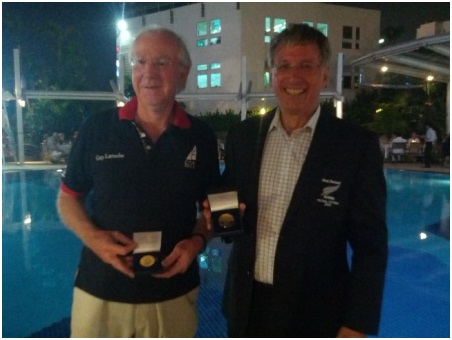
Congratulations Graeme!
The Uffa Fox Gold Medal was instituted by FFI in 2009, to recognise people who had made significant contributions to the Flying Fifteen Class, particularly at the international level. In a way it is something akin to a Life Membership award that is made at National or Club/Class level, because the FFI Constitution does not include any provision for Life Memberships.
Graeme is a F15 tribal elder both in NZ and internationally. He is a 'go-to' person for me for class knowledge which makes writing an article in recognition of his services challenging so in responding to my email questions, he's also become the author. In Graemes words...
I started sailing when I was 30 years old, after returning to Napier and had only been sailing for a couple of seasons, when Ron Warren took me out as crew on his Flying Fifteen 749 “Cimba” in about 1978-79 and I was immediately hooked on the Class, after having crewed a season on a keeler and having owned (and sailed badly) an old OK Dinghy. I crewed for various people, then Gerald Martin and I bought “Ffull Ffrontal” which had been built in late 1981 by Paul Pritchett for charter at the 1982 Worlds, but was not taken up by any of the overseas competitors. With Stu Devine, I sailed in the Pre-Worlds, but just missed out on qualifying for the Napier Worlds. The boat sank the following season and was written off. Ron Warren was New Zealand Chief Measurer and, when I showed interest in the technical side of the Class, he took me under his wing as his assistant measurer. My first overseas sailing experience was at the 1986 Worlds in Hong Kong, where I crewed for Andrew Morrison. Andrew and Roger Craddock bought “Sniffer” and Graham Wiig started building the “Wiigybanks” from a mould taken off her. I helped Ron Warren to measure many of those new breed of Flying Fifteens. Ron supported my application to become an International Class Measurer and I represented FFNZ at Technical Committee meetings at the 1990 Brisbane Worlds, where the Wiigybank winged keels were debated and “grandfathered”. Ron kept sailing until shortly before he died, at which time I became FFNZ Chief Measurer. After Hong Kong, Andrew sailed with his children, so I bought “Roaring Fforty” and crewed for Paul Simmonds for several years. The boat had been built for the 1982 Worlds and was outclassed by the new breed of boats, so I modified the hull, faired the keel and rudder, re-rigged it with an Epsilon mast and bought some new sails, which meant it had another few seasons of good competitive racing in open competition with the Wiigybanks. “Roaring Fforty” last competed at the 1999 Esperance Worlds, where Stephen Wilson and I had some good results for such an old boat (and we had to carry lead weight because the plywood and timber hull had dried out so much in the container when she was shipped over to Australia). As owner/crew, I had the chance to introduce a good few sailors to the Class, including Stephen, David Tucker, Edmund Tam, Carl Banks, James Sandall and others, some of whom have continued to sail Flying Fifteens from time to time. I used to do a bit of Flying Fifteen publicity, with the odd article published in the sailing magazines, including Sea Spray, Boating World and a variety of others that came and went over the years. .For about 20 years or more, through the sailing seasons, I have had a regular radio slot on a Saturday morning sports programme on NewstalkZB Hawke’s Bay and take every opportunity to promote sailing, the Napier Sailing Club and of course the Flying Fifteen Class.
You also hold a role with Yachting NZ, what does that involve?
I was the East Coast North Island representative on the Council of Yachting New Zealand from 1997 until I was elected to the YNZ Board in 2006 (and re-elected in 2008 & 2011). My term on the Board will end later this year. Council was a “conduit” between the Clubs and Regions and the YNZ Board, but it has now been disbanded, with that role being carried out by the YNZ Regional Support Officers. The YNZ Board is responsible for the governance of the sport and recreation in New Zealand and entails about half a dozen meetings each year, with other issues having to be dealt with from time to time.
How did you become involved with Flying Fifteens internationally?
I had the opportunity to crew for Andrew Morrison at the 1986 Hong Kong Worlds, where I met many of the key people in the International Class organisation and then followed that up when I crewed for Jeffrey Morrison in 1990 at Brisbane, when we started our promotion towards the 1994 Timaru Worlds and this was followed up at the Dun Laoghaire Worlds in Ireland in 1992 (where I crewed for Peter Dallimore), when I was co-opted onto the FFI Technical Committee and a few years later I was appointed as a co-opted member of FFI Council. For many years, Ray Sebo, Tony Lee and I were the Technical Committee and, as three engineers from different disciplines, we always worked well together, reviewing the Class Rules, addressing measurement and construction issues and presenting recommended Rule changes to Council for ballot. I think that we have improved the one-design nature of the Flying Fifteen Class, so that the boats are now very similar in performance wherever they are constructed and raced.
For a very weird three or four days in Hayling Island during the 2011 World Championships, I was actually the FFI Commodore between two consecutive meetings of the Council. Greg Wells had completed his two terms as Commodore and in accordance with the Constitution he had to then retire, but all of the National Association representatives and elected Councillors wanted him to remain in the role. To comply with the relevant rules, Greg resigned at a Council meeting, I was appointed Commodore and then at the subsequent meeting three days later I resigned and Greg was elected to replace me and to return for a further two terms as FFI Commodore. I did have a brief but memorable reign. On the lay day between the Pre-Worlds and the Worlds, as Commodore of FFI, I represented the class at the funeral of my good friend and fellow Technical Committee member Tony Lee. A small group of us made the return flights that day from Southampton to Newcastle, to pay our respects to Tony and to extend our sympathies to his lovely wife Brenda. Then, the following day, in Race 1 of the Worlds, James Sandall and I took the gun in our flight and this was apparently the first time in the Class history that the Commodore had won a race at a World Championship. I retired at the meeting the following day, resting on my laurels, and handed the reins back to Greg, who then followed my lead in winning his first race at a Worlds as Commodore.
The medal is awarded in recognition of outstanding services to FFI. What has been your role with FFI? And what does that involve?
I would like to think that it might be for my contributions as summarised above, but then it may simply be because I think I have now competed at more World Championships (12 of the 19 events held since 1979) than anyone else, so it may just be a reward for perseverance.
How did you feel (I'm sure we saw a tear in the eye) when you received the award at the world championship prize giving?
I was absolutely gob-smacked at the Hong Kong Prizegiving Dinner when Rupert Leslie announced the award of the Medal to me and for one of very few times in my life I was stunned into near-silence, beyond thanking FFI for the honour of receiving the award. Neither Sandra Williams (who was FFNZ Delegate to FFI Council) nor I had any inkling that I was going to be receiving the Medal and it came as a complete shock to me and I am sure to all of our small Kiwi contingent at the Dinner. Receiving the award is still such a surprise, as it was to all of the people who (unintentionally) received my “Darling” text that I sent to Judy a few minutes after receiving the Medal, which I inadvertently also sent to most of the people in my cellphone address book. Receiving the Uffa Fox Gold Medal is certainly one of my greatest highlights from my time in sailing, ranking up there as a special and memorable moment with winning the race at the 2011 Worlds, winning the 1989 National Championship with Barry Finlayson and receiving Life Membership of the Napier Sailing Club in 1998.
You join Nigel Peck, Nils Blumann, Roy Windebank, Bill Shand, Sarah Flower, Brenda Lee, Tony Lee, Roger Palmer and Ray Sebo on the honours role. Many of our newer FFNZ sailors may know these names but not the contribution these people made - what can you tell us about these tribal elders?
Nigel Peck AM is a retired Melbourne businessman, who has made very significant contributions to Flying Fifteen Australia. He developed methods for improving the accuracy of measuring Flying Fifteens. A Google search reveals that at the age of 84 years he plans to be Australia’s first astronaut, on a sub-orbit flight scheduled for January 2014 (but I cannot confirm whether the flight will take off on time).
Nils Blumann was a wonderful host of the 1999 Worlds at his local Club in Esperance on the southern coast of West Australia. Between 2003-2006, he was the first FFI Commodore from a country other than England and greatly contributed to the expansion and advancement of the Class and the spread of administration and management beyond the United Kingdom. Nils and his daughter earlier gained fame when they sailed a Flying Fifteen from Esperance westwards around Cape Leeuwin, all the way to Fremantle and up the Swan River to Perth. Have a look at a map of Australia to see how far that is to sail, even with overnight stops along the coastline when conditions allowed.
Roy Windebank was probably the first mass-producer of Flying Fifteen boats, from his base on the south coast of England. He tended to “manipulate” the building tolerances, to construct a series of “improved” fibreglass hulls. By 1986, the Windebank Mark V model had developed rating bumps and that prompted subsequent tightening of the Class Rules and measurement procedures. “Sniffer”, which was the hull from which the Wiigybank mould was taken, was a Windebank V. Later, faired moulds developed from this shape have resulted in the hulls now being very much one-design, whether constructed in England or Australia. There is no doubt that the post Mark V hulls have given us better, fairer and easier-driven boats that can be sailed by a greater variety of sailors. Roy is one of the real characters of the Flying Fifteen class and it was a pleasure to meet up with him again two years ago at Hayling Island, where he lives in retirement.
Bill Shand, from Lindenow, in the Gippsland Lakes region on the south coast of Victoria, Australia has built Flying Fifteens for a great many years. Beautifully crafted, strong and durable hulls were originally to Bill’s own design and were very similar to the Windebank IV hulls, but that mould was superseded when Roy produced his Mark V mould. Bill has produced a string of boats named “Relience” and competed in his (then) latest boat of this name at the 2011 Worlds, when he was aged in his mid-eighties. Bill was rewarded with sail number 4000 for his newest boat out of his mould. He is a wonderful gentleman who still thinks nothing of driving for three days across to West Australia for regattas, towing his and other boats behind his sturdy van.
Sarah Flower was FFI Secretary1975-78, but I am unsure of her contributions to FFI beyond that role. I understand that she may have been a long time contributor to BIFFA and I think it is likely that she was involved with the 1988 Lowestoft Worlds.
Brenda Lee was FFI Secretary/Treasurer in 1997-1998 and Treasurer 1999-2011. In earlier days, she sailed with husband Tony. She has also been heavily involved over the years with BIFFA. It was a real pleasure to meet up with Brenda in Hong Kong, where she stayed for several days during the recent Worlds.
Tony Lee, Brenda’s husband, was a long-serving member of the FFI Technical Committee, right up until his death in 2011. A mechanical engineer and a very practical and pragmatic man, he brought much good knowledge and experience to the Committee. Tony and Brenda so much enjoyed their visit to the 2005 Auckland Worlds that they returned for an extended holiday the following year. Judy and I enjoyed their company, both in the Bay of Islands, when Tony helmed my Flying Fifteen in the Nationals and when they stayed with us in Napier during Art Deco weekend, when Tony drooled over the great display of classic cars. He sailed a race here with me and in 2007 we stayed with Tony and Brenda at North Shields, Newcastle, in the north of England, when I had a great day racing with Tony at his Club at the Derwent Reservoir, while Judy walked on Hadrian’s Wall with Brenda.
Roger Palmer was BIFFA President, before going on to be FFI Commodore between 1999-2002 and during this period, his wife Barbara, who was his regular crew on their Flying Fifteen, served as his secretary. Roger is an International Race Officer with excellent credentials and was Principal Race Officer for the 2011 Hayling Island Worlds.
Ramon Sebo, a chemical engineer from Perth, Western Australia, is a very long-serving member of the Technical Committee and has been FFI Chief Measurer and Technical Committee Chairman since 1995. Under his chairmanship, the Class Rules have been effectively completely rewritten as the ISAF Equipment Rules of Sailing have been amended and reissued. For many years, he has measured Flying Fifteens built in Perth and has attended many World Championships to oversee measurement procedures. His spinnaker measuring jig is a wonder to behold and makes their check-measuring very straightforward. Under his leadership, the strict one-design nature of the Class has been improved and strengthened.
And what of the future for the class, and for your role in NZ and internationally. You have the Worlds coming up in Napier in 2017 what will that entail for you?
The Flying Fifteen Class has continued to flourish since the boat was designed by Uffa Fox in 1947 and has retained its popularity for close competition and pleasurable sailing and racing in a number of countries in Europe, Asia and Australasia. And there have been fleets in Africa and North America. Despite the design being 67 years old, the Flying Fifteen retains its original characteristics of being an easy boat to sail, but a very challenging boat to sail well and I believe that this remains its main attraction, along with the wonderful people who sail in the Class. If we keep introducing people to the Class, so they can appreciate the unique character of the boats and the friendship and fellowship that comes from the sailors who are associated with Flying Fifteens, then I believe that the Class can remain strong into the future. As with the low ebb of members of FFNZ at present, there will be Fleets that come and go, but with support and encouragement from enthusiasts I believe that there are better days still ahead for the Flying Fifteen in New Zealand. There is now the opportunity to plan towards the 2017 World Championships to be hosted by the Napier Sailing Club and that is an exciting prospect for us. I will continue my role on the FFI Technical Committee and hope to be at the coming 2015 Worlds in France, to enjoy renewing old friendships and of course to promote the 2017 Worlds that have been allocated to the Napier Sailing Club.
I have promised Judy that I will be retired and back home by the end of 2014, after spending most of the past three years and more in Christchurch, working on the repair and reconstruction of earthquake damaged homes in that lovely city where I completed my engineering studies back in the 1960s. I plan to have time then to do more Flying Fifteen sailing as a member of the Napier Sailing Club and I am committed to concentrating my efforts into ensuring the success of the 2017 World Championships on my home waters. With the support of current, past and (hopefully lots of) future members of the Flying Fifteen New Zealand Class Association, I am sure that we can make this coming event as memorable as were the 1982 Napier Worlds.
Congratulations Graeme from all the New Zealand F15 sailors.
